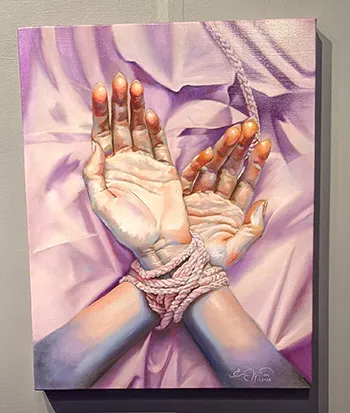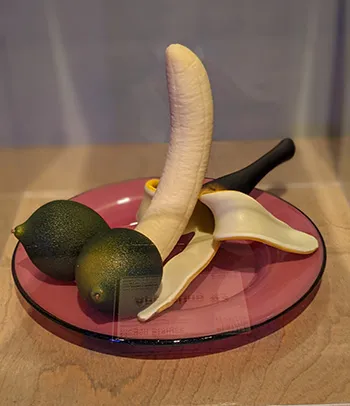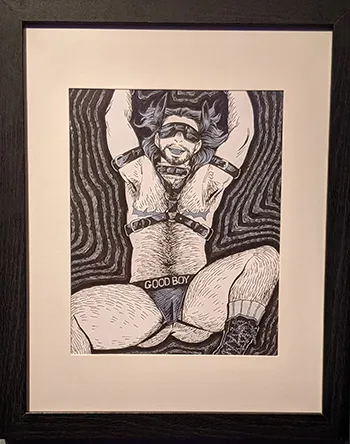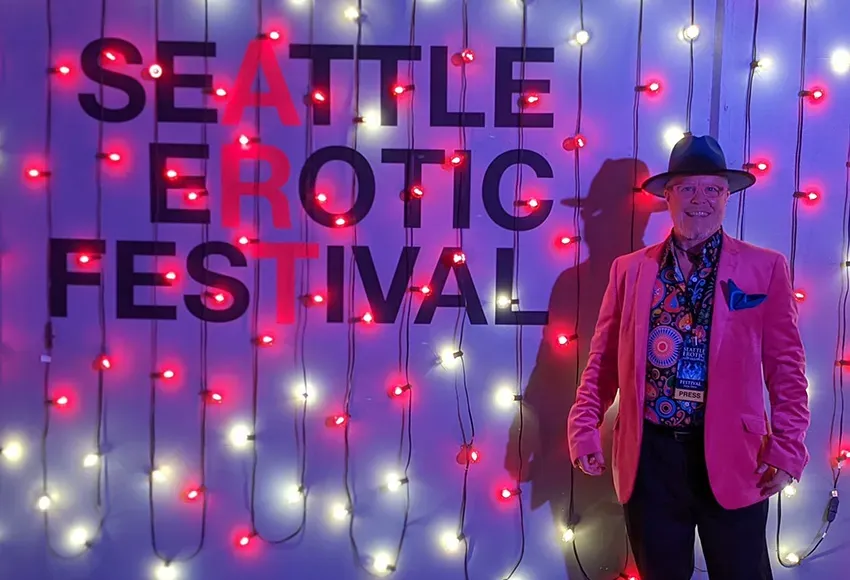The Seattle Erotic Arts Festival (SEAF) has had a rich history since its inception in 2003. It began with a need to create a place to celebrate, discuss, and support pieces rarely seen in mainstream galleries and museums, and a desire to showcase stunning erotic art. It made a lush environment for sexy people to enjoy unique work at an event that joyfully encouraged people to be as open and expressive as they felt comfortable.
Over the years, SEAF has become known for its commitment to showcasing cutting-edge artwork that pushes boundaries and sparks meaningful dialogue. It has provided emerging and established artists with a platform to explore sensuality, intimacy, and human connection innovatively. The festival has embraced inclusivity by featuring diverse perspectives and voices, including those from the LGBTQ+ and BIPOC communities, fostering a more inclusive and welcoming environment for attendees.
In 2008, the festival began to expand, moving to the historic Seattle Center Exhibition Hall beside the Space Needle. In 2019, it celebrated its first year at its year-round home, Gallery Erato, in downtown Seattle, and finally had somewhere to display the growing art collection all year.
The festival's ongoing success and impact underscore its importance as a cultural institution that pushes boundaries, challenges norms, and fosters greater understanding and acceptance of human sexuality.
According to the SEAF mission statement, the festival "encourages the creation, enjoyment, and purchase of erotic art, sparking conversations to ignite personal and cultural evolutions."

Big success
I attended my first SEAF in 2010. As someone who grew up in the South, I had no exposure to this type of freedom of expression and celebration of desire and sexuality. It expanded my world and helped alleviate the shame that I was taught to have around desire and curiosity about sex, eroticism, and expression. They call it "the sex-positive community" here in the Pacific Northwest, but coming from the Southern Baptist world I grew up in, I never thought I would see the words "sex" and "positive" in the same breath. How freeing it was, and is.
I asked Andrew Moran, the festival's art curator, what stands out about this year's festival, which was held on April 26–28. "Each year, people are experiencing this festival for the first time as attendees or new artists who submitted their work to be exhibited," he said. "Seeing them navigate the openness, diversity, and acceptance helps them open and expand."
SEAF was a big success again. A record 51% of all festival art was sold this year, and over 2,000 pieces were sold from the festival store. Through engaging, interactive exhibits, like "Unburden: What Labels Burden You?," attendees examined what labels mean to their lives and learned how to unburden themselves. There was also a creative interactive rope-bondage exhibit with plants hanging off of a person suspended in the air from a pagoda. These pieces fostered introspection and growth and helped attendees examine their biases.
The festival presented all of this in a classy way and with consent – no one is asked to participate in anything without enthusiastic consent. Attendees could go and just quietly take in the art at their own pace, or decide to engage more.
This year, I took a tour with some of the literary artists who are in the 2024 SEAF anthology book, who wrote poems about certain pieces at this year's festival that spoke to them in some way. It was lovely to get a glimpse into how the art spoke other writers as they read their poems.

The power of erotic art
Erotic art has the power to help people erase shame by challenging societal taboos, promoting self-acceptance, and fostering open dialogue about sexuality. Here are a few ways in which it accomplishes this:
• Normalizing human desire: Erotic art portrays sexuality and desire as natural and everyday aspects of the human experience. By depicting eroticism in various forms, it helps people recognize that others share their passions and that these are not something to be ashamed of.
• Celebrating diversity: Erotic art often celebrates the diversity of human bodies, desires, and experiences. By showcasing a wide range of expressions of sexuality, including LGBTQ+ perspectives, it helps to validate and normalize diverse identities and desires, reducing feelings of shame associated with not conforming to societal norms.
• Challenging stigma: Erotic art can challenge the stigma and shame surrounding certain sexual practices or identities by presenting them in a positive and affirming light. Portraying taboo subjects with respect and dignity helps to break down stereotypes and misconceptions, empowering people to embrace their authentic selves without shame.
• Creating safe spaces: Erotic art exhibitions and festivals provide safe and inclusive spaces for people to explore and engage with sexuality and eroticism free from judgment or censure. These environments encourage open dialogue and self-expression, fostering a sense of community and acceptance that can help attendees overcome feelings of shame.
• Promoting self-expression: Engaging with erotic art can encourage attendees to explore and express their desires and fantasies more openly. By seeing their desires reflected in art, people may feel more comfortable embracing and expressing their sexuality, leading to greater self-acceptance and reduced shame.
Let's dive a little deeper into how freedom of expression can profoundly impact a person's life in several ways:
• Self-expression: Freedom of expression allows people to express their thoughts, opinions, and beliefs without fear of censorship or punishment. This ability to express oneself freely is crucial for personal development and self-fulfillment. It enables individuals to articulate their identities, share their unique perspectives, and contribute to public discourse.
• Empowerment: When people are free to express themselves, they feel empowered and more in control of their lives. They have the confidence to voice their concerns, advocate for their rights, and participate actively in shaping their communities and societies.
• Creativity and innovation: Freedom of expression fosters a culture of creativity and innovation. It encourages people to explore new ideas, challenge existing norms, and push boundaries in various fields such as art, literature, science, and technology. Without the fear of censorship or reprisal, people are likelier to experiment and innovate.
• Social and political change: Freedom of expression is fundamental to democracy and social progress. It enables citizens to engage in political discourse, criticize government policies, and advocate for change. Through freedom of expression, people can raise awareness about social injustices, mobilize support for causes, and hold those in power accountable.
• Personal growth and learning: When people are free to express themselves, they are exposed to diverse perspectives and ideas. This exposure facilitates personal growth and intellectual development as they engage in debates, exchange viewpoints, and learn from one another.
• Emotional well-being: Being able to express one's thoughts and feelings openly can positively affect mental and emotional well-being. Suppressing emotions or censoring oneself can lead to feelings of frustration, resentment, and isolation. Freedom of expression provides an outlet for authentic self-expression, which can promote emotional resilience and psychological health.

Freedom of expression is not just a legal or political concept; it's a fundamental human right that profoundly shapes lives, societies, and the world.
Overall, erotic art plays a valuable role in challenging societal attitudes toward sexuality, promoting self-acceptance, and creating spaces where people can explore their desires without shame or judgment. We are lucky to have a large and successful erotic arts festival in Seattle that promotes diversity and self-expression, challenges stigmas, normalizes human desires, creates safe spaces for all, and supports fantastic artists.
I encourage those of you who have never experienced SEAF to plan to attend next year and approach with a curiosity to learn, grow, and be open to new thoughts and experiences.
The 2025 SEAF call for art opens December 1, 2024; interactive elements and large-scale art will be solicited earlier in the fall. Learn more at https://www.seattleerotic.org


